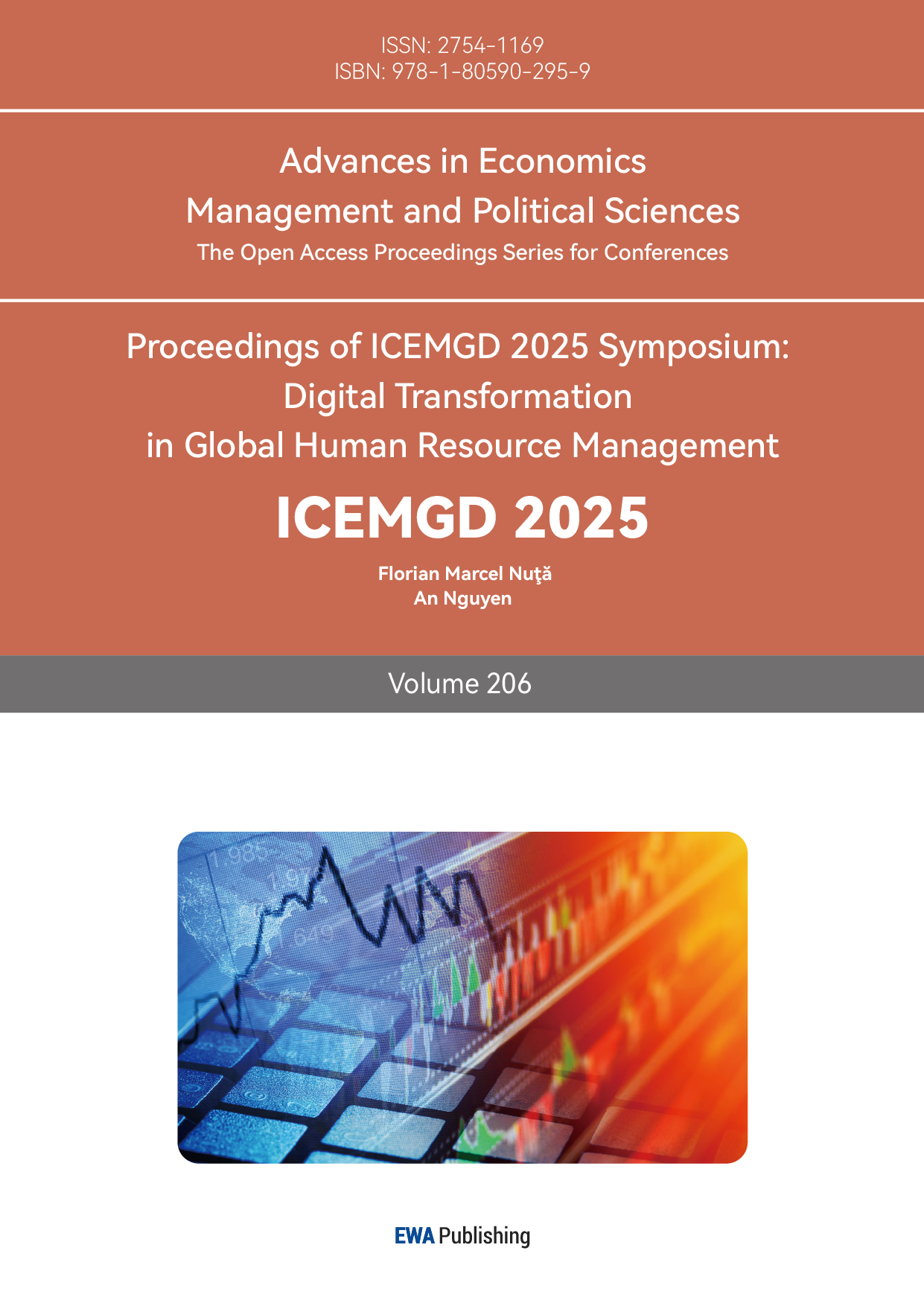References
[1]. Li, H., Wei, Y. D., & Yu, Z. (2016). Urban land expansion and spatial dynamics in globalizing Shanghai. Sustainability, 8(6), 537.
[2]. Tu, Y., & Bao, H. X. (2019). Housing price dynamics with development cycles: Evidence from China. Land Use Policy, 87, 104065.
[3]. Wu, J., Gyourko, J., & Deng, Y. (2012). Evaluating conditions in major Chinese housing markets. Regional Science and Urban Economics, 42(3), 531-543.
[4]. Zhang, L., Sun, T., & Feng, T. (2018). Housing price bubbles in China: A tale of 35 major cities. Applied Economics, 50(36), 3911-3923.
[5]. Chen, J., & Han, X. (2014). The evolution of the housing market and its socioeconomic impacts in the post-reform People's Republic of China: A survey of the literature. Journal of Economic Surveys, 28(4), 652-670.
[6]. Deng, Y., & Liu, P. (2019). Mortgage pre-payment and default behavior with embedded forward contract risks in China's housing market. Journal of Housing Economics, 43, 1-12.
[7]. Fang, H., Gu, Q., Xiong, W., & Zhou, L. A. (2015). Demystifying the Chinese housing boom. NBER Macroeconomics Annual, 30(1), 105-166.
[8]. Liu, Z., Wang, Y., & Tao, R. (2013). Urban land policies and housing prices: Evidence from Chinese cities. The Quarterly Review of Economics and Finance, 53(4), 352-359.
[9]. Ren, Y., Xiong, C., & Yuan, Y. (2012). House price bubbles in China. China Economic Review, 23(4), 786-800.
[10]. Elhorst, J. P. (2014). Spatial econometrics: From cross-sectional data to spatial panels. Springer.LeSage, J., & Pace, R. K. (2009). Introduction to spatial econometrics. CRC Press.
[11]. Anselin, L. (2005). Spatial statistical modeling in a GIS environment. In GIS for the urban environment (pp. 93-111). ESRI Press.
[12]. Wheaton, W. C. (1990). Vacancy, search, and prices in a housing market matching model. Journal of Political Economy, 98(6), 1270-1292.
[13]. Zhang, Y., & Sun, L. (2020). The impact of housing purchase restriction policies on urban housing prices: Evidence from 70 Chinese cities. Habitat International, 97, 102120.
[14]. Anselin, L., & Bera, A. K. (2003). Spatial dependence in linear regression models with an introduction to spatial econometrics. In Handbook of applied economic statistics (pp. 237-289). Marcel Dekker.
[15]. Case, K. E., & Shiller, R. J. (2003). Is there a bubble in the housing market? Brookings Papers on Economic Activity, 2003(2), 299-362.
[16]. Case, K. E., & Shiller, R. J. (1989). The efficiency of the market for single-family homes. American Economic Review, 79(1), 125-137.
[17]. Chen, J., Guo, F., & Zhu, A. (2020). The heterogeneous impact of housing purchase restrictions on urban prices: Evidence from 283 Chinese cities. Journal of Housing Economics, 50, 101716.
[18]. Li, X., Wei, Y. D., & Yu, C. (2021). Spatial inequality of housing prices in China: Evidence from machine learning and spatial econometrics. Annals of the American Association of Geographers, 111(3), 835-856.
[19]. Gyourko, J., Mayer, C., & Sinai, T. (2022). Superstar cities and machine learning: Predicting commercial real estate price dynamics. Journal of Urban Economics, 130, 103456.
[20]. Mullainathan, S., & Spiess, J. (2017). Machine learning: An applied econometric approach. Journal of Economic Perspectives, 31(2), 87-106.
[21]. Hastie, T., Tibshirani, R., & Friedman, J. (2017). The elements of statistical learning (2nd ed.). Springer.
[22]. undberg, S. M., & Lee, S. I. (2020). SHAP values for explaining machine learning models. Advances in Neural Information Processing Systems, 33, 1-12.
[23]. Gu, Q., Zhou, L., & Yao, Y. (2021). Machine learning vs hedonic models: Asian commercial property valuation revisited. Real Estate Economics, 49(4), 1125-1158.
[24]. Lundberg, S. M., & Lee, S.-I. (2017). A unified approach to interpreting model predictions. Advances in Neural Information Processing Systems, *30*, 4765–4774.
[25]. Bergstra, J., & Bengio, Y. (2012). Random search for hyper-parameter optimization. Journal of Machine Learning Research, *13*(1), 281-305.
[26]. Kok, S., Koponen, J., & Lönnqvist, H. (2022). Combining machine learning and econometrics for real estate price prediction. Journal of Housing Economics, *55*, 101817.
[27]. Wooldridge, J. M. (2020). Introductory econometrics: A modern approach (7th ed.). Cengage Learning.
[28]. Zhang, L., Wei, Y., & Zhang, P. (2023). Deep learning for real estate valuation: Performance and interpretability trade-offs. Journal of Property Research, 40(2), 145-167.
[29]. LeSage, J. P., & Pace, R. K. (2021). Spatial econometric model comparison using information criteria. Spatial Economic Analysis, 16(3), 312-331.
[30]. Dickey, D. A., & Fuller, W. A. (1981). Likelihood ratio statistics for autoregressive time series with a unit root. Econometrica, 49(4), 1057-1072.
[31]. Johansen, S. (1991). Estimation and hypothesis testing of cointegration vectors in Gaussian vector autoregressive models. Econometrica, 59(6), 1551-1580.
[32]. White, H. (1980). A heteroskedasticity-consistent covariance matrix estimator and a direct test for heteroskedasticity. Econometrica, 48(4), 817-838.
[33]. Zhang, Y., & Chen, J. (2021). Data quality in emerging real estate markets: Measurement errors and estimation biases. Journal of Real Estate Research, 43(3), 321-345.
[34]. Li, X., Wang, R., & Liu, Y. (2022). Machine learning in real estate prediction: A meta-analysis of model performance. Real Estate Economics, 50(4), 1128-1165
[35]. Chen, L. (2020). Measuring policy impacts in real estate: Beyond dummy variables. Urban Studies, 57(14), 2987-3010.
[36]. Wang, H., & Liu, Y. (2023). Mixed-frequency data modeling in real estate markets: A MIDAS approach. Journal of Real Estate Finance and Economics, 66(2), 189-215.
[37]. Thompson, E., & Garcia, R. (2023). A DSGE framework for real estate market analysis. Journal of Housing Economics, 59, 101936.



